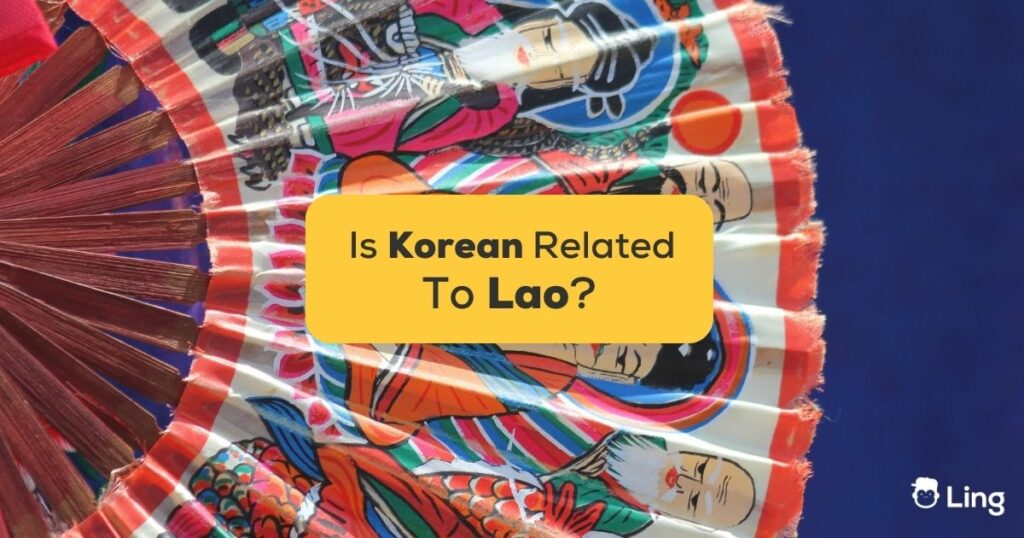When was the last time you walked into a house party only to find you and a complete stranger sharing uncanny similarities? It’s a thrill, isn’t it? The same indescribable sensations grip language enthusiasts when they explore the connections between seemingly disparate languages. Today, we’re about to walk into that same party with a million-dollar question in our pockets: “Is Korean related to Lao?”
In this blog, we’ll go over the timeless Hangul as it meets graceful Lao script—is there a secret kinship tucked away behind these intricate symbols and tunes, waiting to be unearthed? Or are these two languages just like chalk and cheese, mesmerizing in their independent glory but miles apart in their essence? Whether you’re a fervent linguaphile, a random trivia collector, or someone planning an Asian backpack trip, this unraveling is going to pique your curiosity. Let’s begin!
Korean Language
Ever wondered what it feels like to crack the code of an ancient treasure map? Learning Korean is a similar roller-coaster ride, sprinkled with aha moments and filled with riddles asking for your attention. Let’s dive straight into the heart of Hangul, shall we?
Korean, the linguistic pride of the Korean Peninsula, is a language draped in age-old history yet brimming with modern-day flair. It’s the mother tongue of about 75 million people, making it among the world’s top 20 most-spoken languages!
Before you get apprehensive about conquering new linguistic mountains, here’s some fairy dust: Korean is regarded as one of the most logical languages globally. Remember Pythagoras’ theorem? The Korean language’s structure and grammar are far more straightforward. No kidding!
One of the crown jewels of Korean is its unique writing system, Hangul. Created under King Sejong the Great’s patronage in the 15th century, Hangul boasts 14 consonants and 10 vowels, which team up to form syllabic blocks. This warm style is what gives Korean its symphony of symbols. It’s like playing with LEGO, but instead of creating castles and cars, you’re crafting sentences and stories!
Cautiously crafted over time to eliminate language barriers among the common folk, Hangul stands out in its accessibility and simplicity. It’s said that a dedicated learner can master Hangul in just a few hours. Come on, that’s less time than a Tolkien’s trilogy movie marathon!

How Long Does It Take To Learn Korean?
Picture yourself in the bustling heart of Seoul or surrounded by the serenity of a North Korean mountain range, exchanging greetings with locals, impressing Korean tourists, and bragging about your kimchi-making prowess. Sounds enticing, right? So, how long will it take to master the enchanting language of Korea? Grab a cup of soothing green tea, and let’s find out together!
Curiosity revs up as we tackle the Korean language, spoken by South Korea and North Korea, making it the linguistic pride and joy of the Korean Peninsula. Rest assured, the time it takes to learn Korean varies between individuals and relies on multiple factors, such as language exposure, motivation, and study methods.
According to the American Foreign Service Institute (FSI), Korean falls into Category IV—a group of languages estimated to require 2,200 hours of study for English speakers to reach fluency. That translates to about 88 weeks or roughly 1.7 years of devoted language learning.
But wait, don’t get disheartened just yet! The hours mentioned above assume that you’re starting from scratch. If you know some Chinese or Japanese, your Korean learning journey might speed up, taking fewer detours through vocabulary town. Plus, our journey’s excitement level optimizes when we move past conventional classrooms and plunge into South Korean dramas, K-pop lyrics, and engaging language exchange sessions.
Closest Language To Korean
What do Korean and the mythical creature, the unicorn, have in common? Well, it turns out they both share that air of mystery and intrigue! Just as unicorns stand proud and unique with their single spiraling horn, the Korean language struts as a one-of-a-kind language isolate.
But what is a language isolate, you ask? Let us unravel this linguistic riddle!
A language isolate refers to a language that doesn’t lean towards any other language family, making it the quintessential loner of the language world. The Korean language, poised as the official language for both South and North Korea, dons the mantle of an isolate with style, distanced from its distant relatives like Lao, Thai, and Vietnamese languages.
The thrill doesn’t end there, though! When diving into the depths of the Korean language, we stumble upon a charming find: the Jeju language. Spoken predominantly on Jeju Island in South Korea, this enticing dialect is distinct and draws linguistic enthusiasts ever closer to its intricately woven tapestry.
Lao Language
Come, let’s pull back the curtain and get up close with Lao, the official language of Laos, otherwise known as Laotian. Home to over 7 million speakers, Lao is a multi-dimensional linguistic adventure that offers a deeper panorama of this serene Southeast Asian cultural landscape.
If languages were melodies, Lao would be a beautifully composed piece for a six-stringed guitar. It’s a tonal language, with each word having potentially six different meanings based on the tone in which it’s spoken. Try this: the word ‘hai’ could mean to ‘open’, ‘give’, ‘burn’, ‘cut’, ‘to be’ or ‘excrete’, according to the tone. It’s like a verbal chameleon!
Remember the iconic Tetris game? The Lao script slightly hovers on that concept. It’s written from left to right, with consonants, vowels, tone marks, and other signs having specific positions relative to each other.
Navigating through the intricacies of Lao might initially seem like threading a needle on a roller coaster. Still, once you’re familiar with the tones and get the hang of the unique script, it transforms into a rewarding endeavor.
Being an isolate within the Tai language family, Lao proudly preserves its invaluable cultural essence and enriches the linguistic diversity on the global map. Decoding Lao could paint a mesmerizing picture of Laos that extends beyond its stunning sunsets and intricate temple architecture.

How Long Does It Take To Learn Lao?
As the official language of Laos and counting few words from its ethnic groups, Lao is a language that hums in the ears of about 30 million people, primarily in Laos and Northeastern Thailand. Lao dialects, like Northern Lao and Vientiane Lao, also played the real-life role of ‘Variety Spices Things Up!’, making the journey of mastering Lao a compelling one.
According to encompassing data, for English speakers, the duration to unlock fluency in the Lao language could vary, thanks to the whimsy of different individual learning styles and the method of instruction. However, the Foreign Services Institute (FSI) rating suggests that Lao stands among the languages that might require 44 weeks or approximately 1,100 hours. That’s less than a full Game of Thrones binge, for sure!
This linguistic elopement’s thrill only hikes when it comes to tones. The six tones of Lao language add a spicy flavor, making the communicative curry tastier and more amusing. And don’t forget about Laos’s French influence! It sprinkles a little ‘ooh la la’ onto Lao vocabulary along the way.
On a sweeter note? That seemingly uphill climb is made more manageable thanks to the similarities between Lao, the Thai language, and some Vietnamese traits. So, for all those Thai or Vietnamese language maestros, this is your pass to cut the line!
Closest Language To Lao
Believe it or not, the sibling to Lao isn’t Korean — but Thai. Yes, that’s right! The Thai language is such a dead ringer for Lao that they could be mistaken for twins at a language family reunion!
Lao and Thai, headquartered respectively in Laos and Thailand (yes, they decided to name the countries after themselves, talk about self-love!), have a lot in common. These two languages, cheek by jowl in Southeast Asia, way beyond the reaches of North and South Korea, share similar grammar, vocabulary, and even intonations. This makes them mutually intelligible to a considerable extent, much like the way Hollywood movies heaps sequels onto successful franchises.
Even more intriguing, these two languages exhibit an uncanny sibling bonding through their dialects! The various Lao dialects, like Northern Lao and Vientiane Lao, could find their matching puzzle pieces in corresponding Thai dialects. So, they’re basically linguistic peas in a pod.
Is Korean Related To Lao?
While both languages command a spectacular performance on the linguistic stage, sorry to burst your bubble, but Korean is not related to Lao. A tantalizing twist, eh? That, my friends, is where the plot gets intriguing. You see, Korean is a spectacular spectacle of a language isolate, an elusive unicorn in the vast linguistic landscape. Meanwhile, Lao, hailing from the talented Tai-Kadai language family, performs energetically in the rich locales of Laos, its script serenading the Southeast Asian wind.
So, while they might exchange polite nods at international linguistic conventions or even borrow each other’s vernacular outfits once in a while, Korean and Lao have different ancestral roots in the language family tree.
Learn Korean With Ling
If this expedition has sparked your linguistic wanderlust and you’re yearning to dive into the thrilling waters of the Korean language, there’s more good news in store for you!
You can take your curiosity on a joyride and learn Korean right from the comfort of your couch (or wherever you fancy!). And how might you accomplish this epic journey, you ask? Meet your trusty sidekick: the Ling app!
The Ling app is your compass to navigate the captivating world of Korean. Bursting with streamlined courses tailored to cater to your zeal for exploring languages, this app is your ticket to mastering Hangul slices at your own pace.
So, whether you’re an avid language learner, a dedicated soap opera fan hoping to decipher those dramatic Korean dialogues, or simply drawn to the linguistic allure of the Korean language, Ling’s got your back.
Ready to join the ranks of countless Korean enthusiasts? Strap on your linguistic backpack and download the Ling app from the App Store or Play Store. Your passport to this newfound linguistic adventure awaits!



































































